Professional organizers avoid these common storage solutions because they waste space and make access difficult. Tapered and irregular containers leave gaps and hinder stacking, while opaque bins hide contents and slow organization. Natural fiber baskets attract pests and are hard to clean, compromising hygiene. Non-adjustable shelving limits flexibility, encouraging clutter. Bulky units take up too much space and reduce adaptability. Stay with us to discover better alternatives that maximize efficiency and keep your space tidy.
Key Takeaways
- They avoid tapered or irregular containers that waste space and hinder efficient stacking and organization.
- Opaque bins are not used because they obstruct visibility, slowing access and inventory checks.
- Natural fiber baskets are avoided due to hygiene concerns, moisture absorption, and pest attraction.
- Non-adjustable shelving is rejected for limiting customization and reducing usable vertical space.
- Bulky, purpose-specific units are disregarded for their inflexibility and inefficient use of space.
Tapered and Irregularly Shaped Containers Waste Space and Stifle Stacking
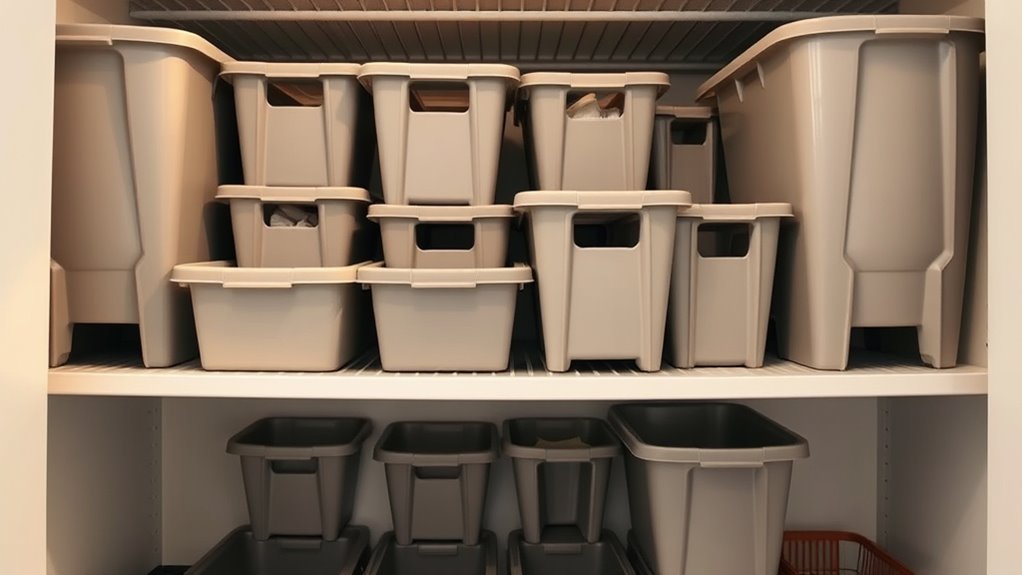
Tapered and irregularly shaped containers often waste space and make stacking difficult because they don’t fit together tightly. Tapered containers with irregular shapes leave gaps when placed side by side, reducing overall storage efficiency. This stacking inefficiency means you can’t maximize vertical or horizontal space, leading to clutter and wasted storage space. These containers typically require more shelf or drawer space than uniform containers, making organization harder. Because they don’t stack securely, there’s a higher risk of tipping and spills, creating safety concerns. Professional organizers prefer uniform containers with straight sides because they optimize space utilization and simplify organization. Using straight-sided, rectangular containers ensures seamless stacking and better storage solutions, making the most of every inch of your available space. Additionally, storage container shapes can significantly impact how efficiently you use your storage space and maintain an organized environment. Incorporating stackability features into storage containers can further enhance organization and space savings. Properly designed containers with interlocking mechanisms can provide extra stability, especially in busy households or workplaces.
Opaque Bins Obscure Contents and Hamper Quick Access
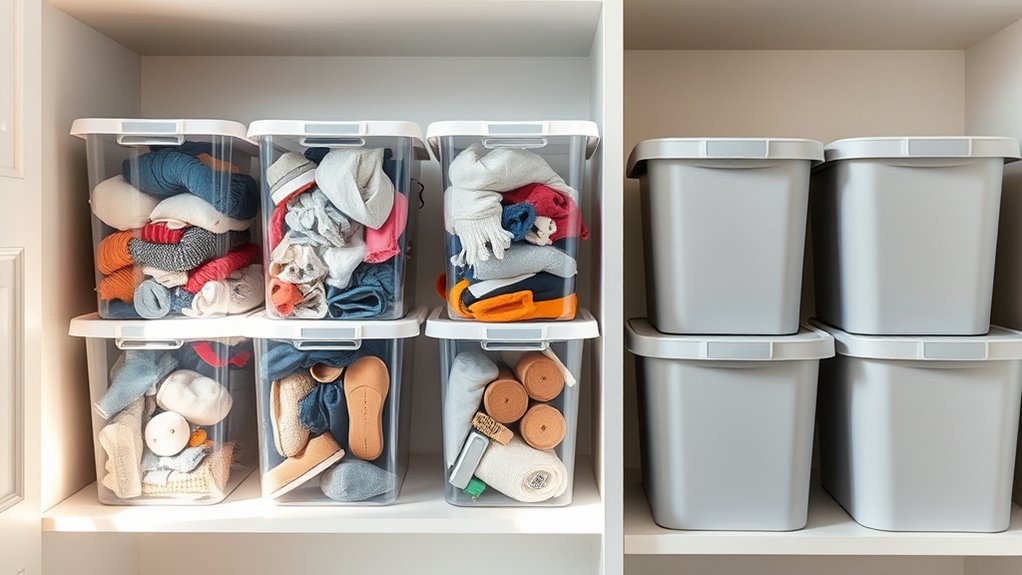
Opaque bins can considerably slow down your organization process because their contents aren’t visible at a glance. This lack of visibility makes it harder to find what you need quickly, leading to wasted time and frustration. Without a clear visual inventory, you might forget what’s stored inside, causing duplicate purchases or neglected items. Relying solely on opaque bins also discourages regular organization checks, allowing clutter to accumulate. Additionally, the lack of visual access can lead to disorganization and inefficiency in maintaining a tidy space. Using storage solutions that promote transparency can significantly improve your ability to locate items efficiently. For example, clear containers make it easier to identify contents instantly, saving you time during searches. Incorporating organized shelving can further streamline access and categorization. To improve your home organizing, consider these storage solutions:
Opaque bins hinder quick access and can lead to clutter; opt for clear containers and labels for easier organization.
- Switch to clear containers for instant visibility.
- Use labels that are easy to read and update.
- Implement a color-coded system to identify categories quickly.
- Keep frequently accessed items in open or transparent bins for quick access.
Additionally, understanding soulmate angel numbers can inspire you to create a more harmonious and emotionally fulfilling space, motivating you to keep your storage areas organized. These strategies help streamline organization and reduce clutter.
Natural Fiber Baskets Harbor Pests and Compromise Hygiene
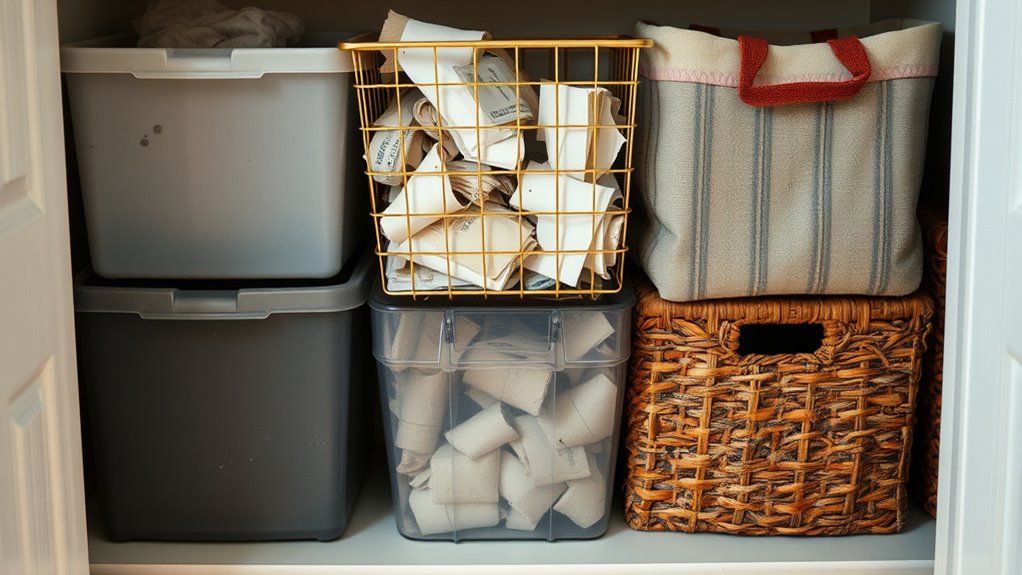
While clear containers improve visibility and access, natural fiber baskets present new challenges for maintaining hygiene and pest control. These baskets, made from grass, wicker, or straw, are porous materials that absorb moisture, increasing mold growth and creating ideal conditions for pests like mites, beetles, and ants. Their tiny gaps can attract insects and serve as nesting sites, making pest control more difficult. Additionally, natural fiber baskets are hard to clean thoroughly, allowing dirt, mold, and pests to accumulate over time. For food storage or hygienic purposes, professional organizers prefer smooth, non-porous storage solutions like plastic or wood because they’re easier to sanitize. Porous materials can harbor bacteria and fungi, further compromising hygiene. Natural fiber baskets, though attractive, compromise hygiene and pose ongoing pest risks, making them unsuitable for organized spaces. Moreover, their inability to be properly sanitized can lead to bacterial contamination, which is a significant concern for maintaining a healthy environment. Using filtration systems, like HEPA filters, in storage areas can help reduce allergen buildup, but natural fiber baskets do not provide this benefit. Additionally, the porous nature of these baskets can increase moisture retention, worsening hygiene issues and pest susceptibility.
Non-Adjustable Shelving Limits Flexibility and Contributes to Clutter
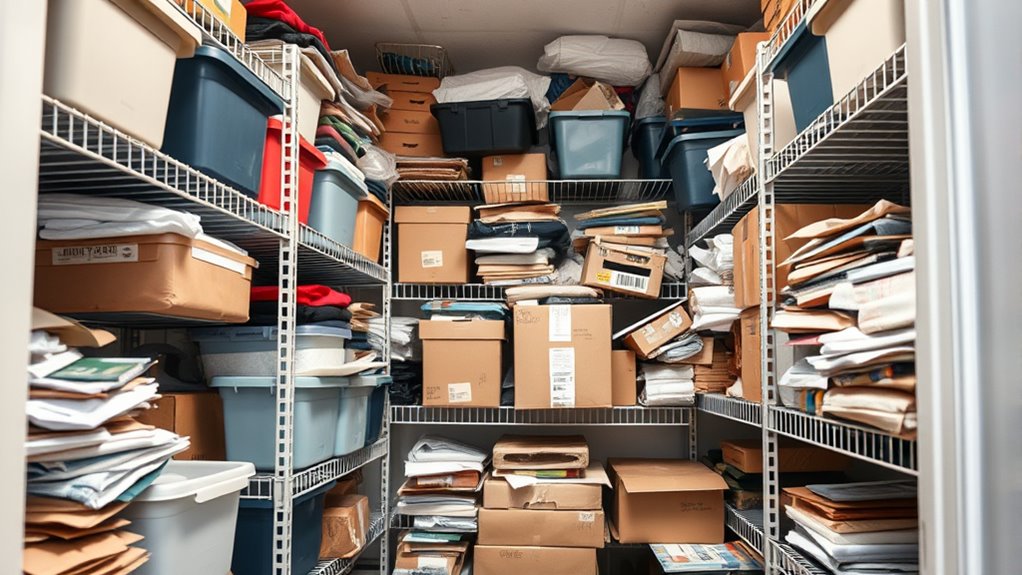
Non-adjustable shelving limits your ability to customize storage spaces, forcing you to fit items into fixed compartments that may be too large or small. This lack of flexibility hampers effective organization and wastes valuable vertical space. When shelves can’t adapt to changing storage needs, you’re more likely to pile or stack items, leading to clutter. Fixed shelves restrict space utilization and prevent you from maximizing your storage potential. To avoid these issues, choose adaptable storage solutions that support ongoing organization. Here’s why non-adjustable shelving isn’t ideal:
- It limits customization to match your current storage needs.
- It causes wasted vertical space, reducing efficiency.
- It discourages proper organization, increasing clutter.
- It diminishes flexibility for future adjustments and growth.
Bulky and Specific Storage Units Fail to Maximize Space and Adaptability
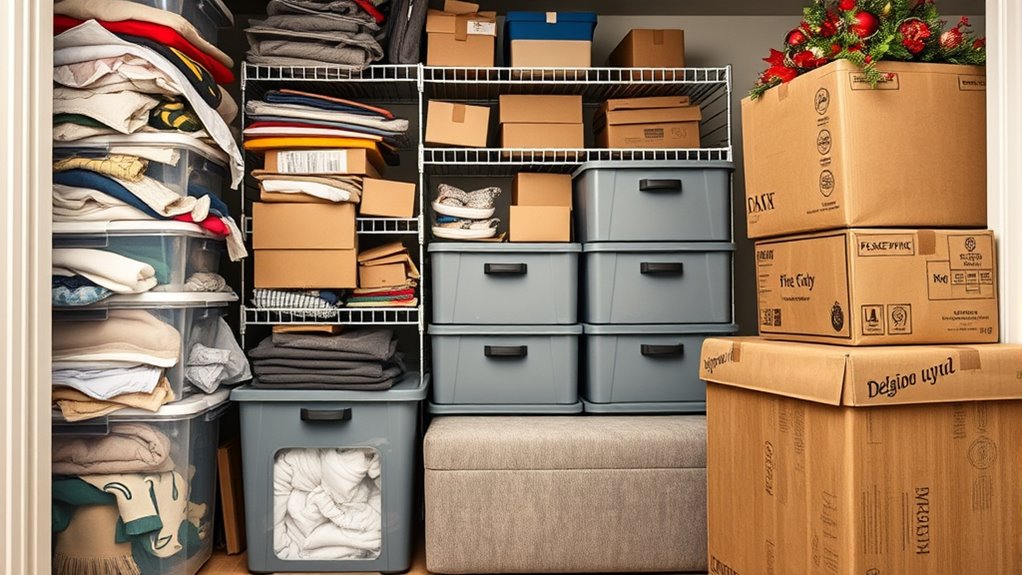
Bulky storage units like large plastic bins or oversized toy containers often take up more space than necessary and make organization less efficient. These oversized containers and specific-purpose organizers, such as DVD towers or wrapping paper racks, limit adaptability and hinder space optimization. Fixed shelving or furniture that isn’t adjustable restricts your ability to customize storage, forcing you to reorganize frequently or accept clutter. Inflexible storage solutions don’t accommodate future items or changes in needs, leading to wasted space and repetitive purchasing. Professional organizers prefer versatile storage options that can adapt as your needs evolve. By avoiding bulky and overly tailored units, you create a more efficient, flexible environment that minimizes clutter and maximizes the usable space in your home. Incorporating modular storage systems enables seamless reconfiguration as your lifestyle or belongings change, promoting long-term organization.
Frequently Asked Questions
Are Decluttering Services Worth It?
You’re wondering if decluttering services are worth it, and the answer is yes. Professional organizers tailor solutions to your habits and space, making your home more functional and less stressful. They help you avoid costly mistakes like overbuying storage or choosing unsuitable options. Plus, they teach you how to maintain your organization long-term, saving you time and money while boosting your productivity and peace of mind.
How Much Should a Professional Organizer Charge?
Think of hiring a professional organizer like investing in a tailored suit; it’s worth every penny. You should expect to pay between $50 and $150 an hour, depending on experience and location. Flat rates for specific projects can range from $300 to $2,500, with full-home services averaging around $1,200 to $3,000. This investment guarantees long-term organization, increased space, and efficiency, saving you time and stress.
Do Professional Organizers Also Clean?
You might wonder if professional organizers also clean, and it varies. Some include cleaning as part of their services to keep your space tidy and maintained, while others focus solely on organizing. You have the option to hire organizers who collaborate with cleaning professionals or do it themselves. It’s best to clarify your needs upfront so they can tailor their services, whether organizing, cleaning, or both.
What Do Professional Organizers Really Do and How Can They Help You?
You might think professional organizers just tidy up, but they do so much more. They assess your lifestyle, identify your priorities, and create customized systems that suit your needs. They help you declutter, choose quality containers, and develop simple habits for lasting order. Their goal isn’t just neat spaces but sustainable organization that makes your life easier, freeing you from chaos and helping you enjoy a calm, functional home everyday.
Conclusion
So, next time you’re tempted to grab those common storage solutions, remember what professional organizers avoid. It’s funny how a simple switch can transform your space—like discovering a hidden gem in a cluttered drawer. When you choose smarter options, you’ll find your home more organized and welcoming. Sometimes, it’s the small changes that unexpectedly make a big difference—turning chaos into calm just when you least expect it.









